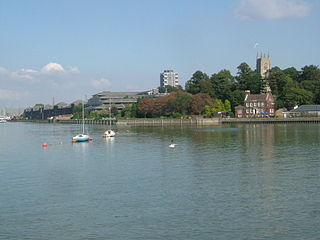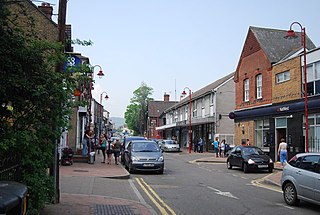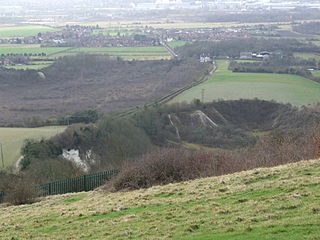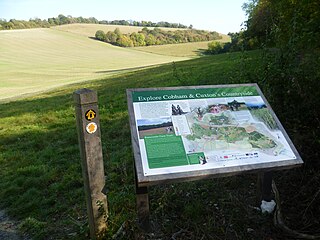
Kent is a county in the South East England region, the closest county to continental Europe. It borders Essex across the entire estuary of the River Thames to the north; the French department of Pas-de-Calais across the Strait of Dover to the south-east; East Sussex to the south-west; Surrey to the west and Greater London to the north-west. The county town is Maidstone.

Maidstone is the largest town in Kent, England, of which it is the county town. Maidstone is historically important and lies 32 miles (51 km) east-south-east of London. The River Medway runs through the centre of the town, linking it with Rochester and the Thames Estuary. Historically, the river carried much of the town's trade as the centre of the agricultural county of Kent, which is known as the Garden of England. There is evidence of settlement in the area dating back before the Stone Age. The town, part of the borough of Maidstone, had an approximate population of 100,000 in 2019. Since World War II, the town's economy has shifted from heavy industry towards light industry and services.

Rochester is a town in the unitary authority of Medway, in Kent, England. It is at the lowest bridging point of the River Medway, about 30 miles (50 km) from London. The town forms a conurbation with neighbouring towns Chatham, Rainham, Strood and Gillingham. Rochester was a city until losing its status as one in 1998 following the forming of Medway and failing to protect its status as a city. There have been ongoing campaigns to reinstate the city status for Rochester.

Medway is a unitary authority and conurbation in Kent, South East England. It had a population of 278,016 in 2019. The unitary authority was formed in 1998 when Rochester-upon-Medway amalgamated with the Borough of Gillingham to form Medway Towns. It is a unitary authority area run by Medway Council, independent of Kent County Council but remains part of the ceremonial county of Kent.

The River Medway is a river in South East England. It rises in the High Weald, West Sussex and flows through Tonbridge, Maidstone and the Medway conurbation in Kent, before emptying into the Thames Estuary near Sheerness, a total distance of 70 miles (113 km). About 13 miles (21 km) of the river lies in East Sussex, with the remainder being in Kent.

Snodland is a town in the borough of Tonbridge and Malling in Kent, England. It lies on the River Medway, between Rochester and Maidstone, and 27 miles (43 km) from central London. At the 2011 Census, it had a population of 10,211.

Strood is a town in the unitary authority of Medway in Kent, South East England. The town forms a conurbation with neighbouring towns Chatham, Rochester, Gillingham and Rainham. It lies on the northwest bank of the River Medway at its lowest bridging point.

Yalding is a village and civil parish in the Borough of Maidstone in Kent, England. The village is situated 6 miles (9.7 km) south west of Maidstone at a point where the Rivers Teise and Beult join the River Medway. At the 2001 census, the parish, which includes the villages of Benover, Laddingford and Queen Street, had a population of 2,236. increasing to 2,418 at the 2011 Census.

The Medway Valley line is the name given to the railway line linking Strood in the Medway Towns via Maidstone West to Tonbridge. High Speed services also link between Maidstone West, Snodland, Strood and London St Pancras International. The section from Maidstone West to Paddock Wood passes through some of Kent's most picturesque countryside along the narrower sections of the River Medway.

Medway was a county constituency represented in the House of Commons of the Parliament of the United Kingdom between 1983 and 2010. A previous constituency of the same name existed from 1885 to 1918.

Lenham is a market village and civil parish in Kent situated on the southern edge of the North Downs, 9 miles (14 km) east of Maidstone. The picturesque square in the village has two public houses, a couple of restaurants, and a tea-room. Lenham has a population of 3,370 according to the 2011 Census.

Eccles is a village in the English county of Kent, part of the parish of Aylesford and in the valley of the River Medway.

Rochester and Strood is a constituency in Kent represented in the House of Commons of the UK Parliament since 2015 by Kelly Tolhurst, a Conservative. Since 2022, she has served as Government Deputy Chief Whip and Treasurer of the Household.

The A228 road is an important transport artery in Kent, England. It begins at the Isle of Grain and runs in a south-westerly direction to connect eventually with the A21 trunk road at Pembury. It serves existing communities and new and proposed housing developments and commercial enterprises. The most influential force on the recent upgrading of the road has been the development of Kings Hill near West Malling.

Ranscombe Farm, in Cuxton in North Kent, is a Plantlife Nature Reserve and working farm. Part of the site is included in the Cobham Woods Site of Special Scientific Interest, and the whole farm is within the Kent Downs Area of Outstanding Natural Beauty.

Wateringbury is a village and civil parish near the town of Maidstone in Kent, England. The Wateringbury Stream flows into the River Medway just above Bow Bridge. It formerly powered three watermills in the village, one of which survives. The Wateringbury railway station is on the Medway Valley Line.
Sir William Whorne was Lord Mayor of London in 1487. He is sometimes also reported as William Horne or William Littlebury.
Sir John Leveson was an English politician. He was instrumental in putting down the Essex rebellion of 8 February 1601.



















